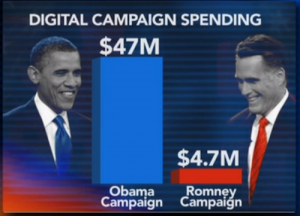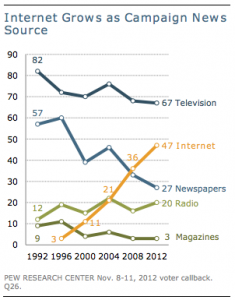The 2008 Obama Presidential campaign made history. Not only was Obama the first African American to be elected president, but he was also the first presidential candidate to effectively use social media as a major campaign strategy. It’s easy to forget, given how ubiquitous social media is today, that in 2008 sending out voting reminders on Twitter and interacting with people on Facebook was a big deal. When Obama announced his candidacy in 2007, Twitter had only just started and there wasn’t even an iPhone yet.
An effective social media campaign is based on the psychology of social behaviors not the current technology

Four years later, the media landscape looks a lot different. There are an ever-increasing number of social media tools and a rapidly growing user base across all demographics. Current measures of American adults who use social networks are at 69%; that’s up significantly from the 37% of those who had social network profiles in 2008. And contrary to concerns about social media causing civic disengagement, numbers out of Pew Research show that 66% of social media users actively engage in political activism online. They estimate that to be the equivalent of 39% of all American adults. Like many other behaviors, online activities translate into offline ones. Researchers at the MacArthur Research Network on Youth & Participatory Politics report that young people who are politically active online are twice as likely to vote than those who are not.
In the run-up to the 2012 presidential election, there was lots of speculation about the potential impact of social media this time around. In 2008, McCain’s campaign was as social-media-deaf as Obama’s was social-media-savvy. Would the Romney campaign be able to compete in the social cyberspace? Would the Obama campaign be able to effectively harness social technologies again?
Like JFK was the first president who really understood television, Obama is the first social media president. In 2012, Obama not only had the expertise on his team, he had an established social media machine up and running. Since social media is about relationships, having a running start building those connections is a distinct benefit. While the Romney campaign was not left in the dust as McCain’s had been, they did not achieve the traction that the Democrats did.

Obama dominated the social media space because his team got how networks work. The real power of social media is not in the number of posts or Tweets but in user engagement measured by content spreadability. For example, Obama logged twice as many Facebook “Likes” and nearly 20 times as many re-tweets as Romney. With his existing social media base and spreadable content, Obama had far superior reach.
The real drivers of an effective social media campaign, however, are based on the psychology of social behaviors not the current technology.
Participatory Democracy
Social media creates a new political dialog. It takes the power of political messaging away from the mass media model and places it firmly into peer-to-peer, public discourse. In the 1950s, sociologists Lazersfeld and Katz proposed a two-step model of communication. Their model proposed that opinions area not formed through direct information from mass media but through individual interactions with opinion leaders who were similar in demographics, interests, and socio-economic factors to those they influenced. In other words, opinion leaders are the people you connect with on your social networks, such as family, friends, colleagues and shared-interest group members. As any marketer will tell you, word of mouth advertising—a recommendation from someone you trust–is the most powerful form of persuasion. Social media creates multiple levels of trust based on relationships. Social media also allows information and opinions to travel across networks, like ripples in a pond, amplifying ideas and allowing each person to participate as an opinion leader through media production and distribution, not just by passive consumption. In the 2012 election, 30% of online users report that they were urged to vote via social media by family, friends or other social network connections, 20% actively encouraged others and 22% posted their decision when the voted.
There are lots of social dynamics that influence people’s opinions and behaviors. From social validation to familiarity that turns into acceptance, social networks and the ability to link peer to peer, supercharge the type of self-organizing movement that Obama’s campaign seeded through strategic social media use.
Individual Agency
The increasing use of social media demonstrates to people the power they have as individuals to make a difference increasing both individual and collective agency. Obama’s group tapped into this increasing sense of political empowerment to generate support in spreading the word, encouraging other voters and raising funds. Social media and text messaging create opportunities for individual involvement that feel personal. Personal encourages participation; participation creates ownership. By encouraging contribution through small donations using the social media and cellphones rather than focusing on the traditional big donor strategy, Obama’s campaign succeeded in raising nearly $1billion not to mention the breadth of social capital.

A Campaign of Memes
The immediacy of social media creates instant channels for memes—an idea or symbol—to take hold and spread rapidly. Memes become a dominant cultural event; they frame or even override other messaging. Romney’s campaign was hurt by their lack of understanding of both this phenomenon and the fluidity of Internet media channels. The most notable meme faux pas was the ‘binders full of women’ remark that started on Twitter and immediately went viral across multiple media including parody accounts on Tumblr, Twitter and Facebook.
The Use of Big Data
A final aspect of the Obama campaign’s social media success comes from the increasing sophistication of online data collection. We may equate data harvesting with large online presences such as Google or Amazon, but they aren’t the only ones mining user data. The ability to collect and analyze data on a large scale allowed the Obama team to model behaviors and coordinate and target communications based. They could, for example, predict which types of people could be persuaded by which forms of contact and content. The Obama field offices ranked call lists in order of persuadability allowing them to predict donor behaviors and to mobilize volunteers to get people out to vote, particularly in the critical swing states.
Smart Social Media Strategy Matters
As the 2012 elections show, social media is no longer the “exciting new frontier” for political campaigning. Social media is a normal and central form of communications with distinctly different properties than traditional mass media approaches. Obama has set the bar for future campaigns but social media and network structures should be given serious attention in the media strategy, whether it’s for politicians, organizations, brands or public service initiatives.
[This article appeared in The National Psychologist January 2013 issue. Reprinted with permission.]
Sources:Social Media Spending http://bearingdrift.com/2012/11/20/social-media-spending-in-the-presidential-election/Obama Yes We Can Twitter art: http://www.mysocialagency.com/obama-social-media-campaign-then-and-now/3759/ and https://smartairmedia.com/content/blogs/blog-sections/social-issues/item/social-media-secret-to-obama-victory
